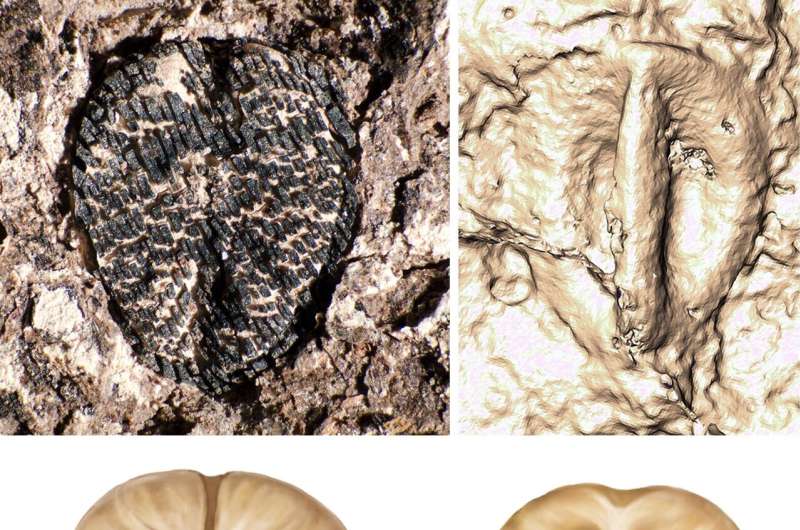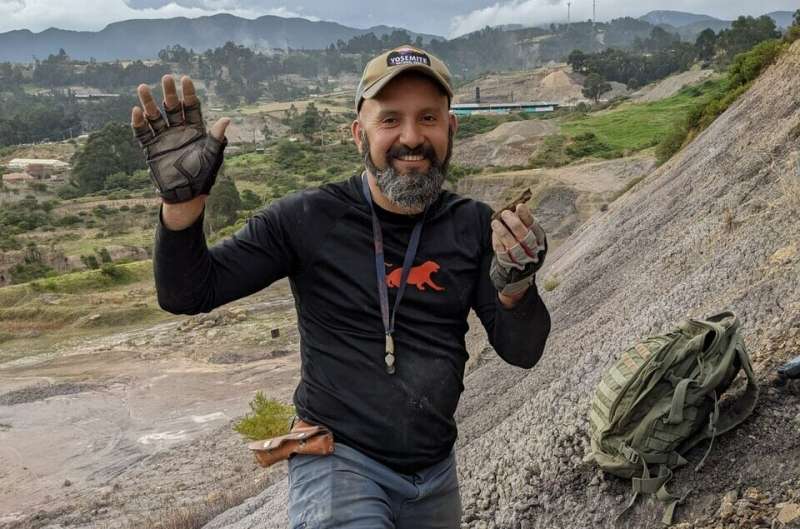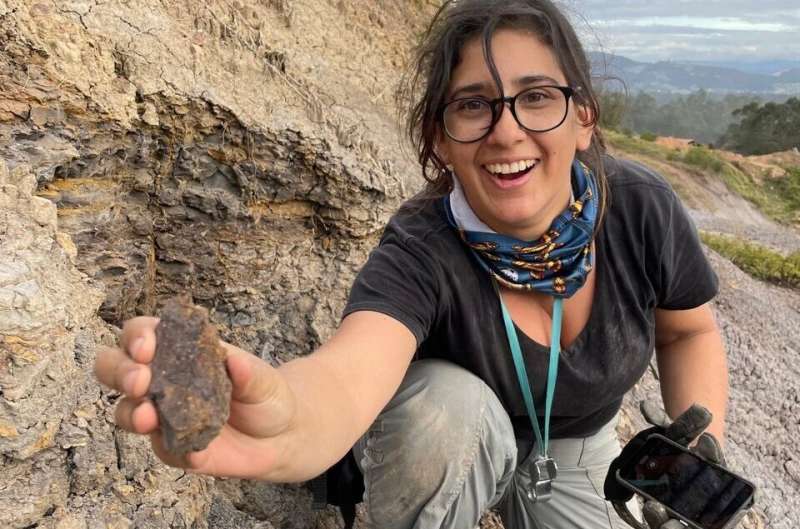
Lithouva – the oldest grape fossil in the Western Hemisphere, approximately 60 million years old and from Colombia. The top figure shows a fossil accompanied by a CT reconstruction. The bottom figure shows a reconstruction by an artist. Credit: Fabiany Herrera, work by Pollyanna von Knorring.
If you’ve ever eaten raisins or enjoyed a glass of wine, you can partly thank the extinction of the dinosaurs. In a discovery described in the journal Nature Plantsresearchers have discovered fossilized grape seeds that are 60 to 19 million years old in Colombia, Panama, and Peru. One of these species represents the earliest known example of a grape family plant in the Western Hemisphere. These fossil seeds help show how the grape family spread in the years after the dinosaurs died out.
“These are the oldest grapes ever discovered in this part of the world, and they are a few million years younger than the oldest grapes ever discovered on the other side of the planet,” explains Fabiany Herrera, assistant curator in paleobotany at the Field Museum at the Negaunee Integrative Research Center in Chicago and lead author of the study. “This discovery is important because it shows that after the extinction of the dinosaurs, grapes began to spread throughout the world. »
It is rare for soft tissues like fruits to be preserved as fossils. Scientists therefore often understand ancient fruits through seeds, which are more likely to fossilize. The oldest known grape seed fossils were discovered in India and date back 66 million years. It’s no coincidence that grapes first appeared in fossils 66 million years ago, around the time a massive asteroid hit Earth, triggering a mass extinction that altered the course of life on the planet.
“We always think about animals, dinosaurs, because they were the most affected, but the extinction also had a huge impact on plants,” says Herrera. “The forest has regenerated, which has changed the composition of the plants. »
Herrera and his colleagues speculate that the disappearance of dinosaurs may have contributed to changes in forests. “Large animals, like dinosaurs, are known to change the ecosystems around them. We think that if large dinosaurs were roaming the forest, they were probably cutting down trees, which helped keep forests more open than they are today,” says Mónica Carvalho, a co-author of the study and an assistant curator at the University of Michigan Museum of Paleontology.
But without large dinosaurs to carve them up, some rainforests, particularly those in South America, became more densely populated, with layers of trees forming an understory and canopy.

Lead author Fabiany Herrera holds a fossil of the oldest grape ever discovered in the Western Hemisphere. Credit: Fabiany Herrera
These new dense forests paved the way for such an evolution. “At this time, fossils show that more and more plants climbed trees using lianas, such as vines,” says Herrera. The diversification of birds and mammals in the years following the mass extinction may also have helped the spread of the vine.
In 2013, Herrera’s Ph.D. The new paper’s advisor and lead author, Steven Manchester, published a paper describing the oldest known grape seed fossil, from India. Although no fossil grapes had ever been found in South America, Herrera suspected they might be there as well.
“Grapes have been known for 50 million years, so I wanted to find one in South America, but it was like looking for a needle in a haystack,” Herrera says. “I’ve been looking for the oldest grape in the Western Hemisphere since I was an undergraduate.”
But in 2022, Herrera and co-author Mónica Carvalho were conducting fieldwork in the Colombian Andes when a fossil caught Carvalho’s attention. “She looked at me and said, ‘Fabiany, a grape!’ And then I looked at it, I was like, ‘Oh my God.’ It was so exciting,” Herrera recalls. The fossil was in a 60-million-year-old rock, making it not only the first grape fossil from South America, but also one of the oldest grape fossils in the world.

Mónica Carvalho, co-author of the paper, holding the fossil of the oldest grape seed found in the Western Hemisphere. Credit: Fabiany Herrera
The fossilized seed itself is tiny, but Herrera and Carvalho were able to identify it by its particular shape, size and other morphological characteristics. Back at the lab, they performed CT scans showing its internal structure, which confirmed its identity.
The team named the fossil Lithouva susmanii, “Susman’s stone grape,” in honor of Arthur T. Susman, a proponent of South American paleobotany at the Field Museum. “This new species is also important because it confirms the South American origin of the group in which the common grapevine Vitis evolved,” said Gregory Stull, a co-author of the study and a fellow at the National Museum of Natural History.
The team continued their field work in South and Central America, and in the paper published in Nature Plants, Herrera and his co-authors ultimately described nine new species of fossilized grapes from Colombia, Panama and the Peru, dating from 60 to 19 million years ago. These fossilized seeds tell the story not only of the spread of grapes across the Western Hemisphere, but also of the numerous extinctions and dispersals this grape family has undergone.
Fossils are only distant relatives of grapes native to the Western Hemisphere, and a few, such as the two Leea species, are now found only in the Eastern Hemisphere. Their place in the grape family tree indicates that their evolutionary journey has been tumultuous.
“The fossil record tells us that grapes are a very resilient order. It is a group that has suffered greatly from extinction in the Central and South American region, but it has also managed to adapt and survive in other parts of the world,” Herrera says.
Given the mass extinction our planet is currently facing, Herrera believes studies like this are valuable because they reveal patterns in how biodiversity crises occur. “But the other thing I love about these fossils is that these humble little seeds can tell us a lot about the evolution of the forest,” Herrera says.
This study was authored by Fabiany Herrera (Field Museum), Mónica Carvalho (University of Michigan), Gregory Stull (National Museum of Natural History, Smithsonian Institution), Carlos Jarramillo (Smithsonian Tropical Research Institute), and Steven Manchester (Florida Museum of Natural History, University of Florida).
More information:
Cenozoic seeds of Vitaceae reveal a long history of extinction and dispersal in the Neotropics, Nature Plants (2024). DOI: 10.1038/s41477-024-01717-9
Quote:Sixty-million-year-old grape seeds reveal how the death of dinosaurs may have paved the way for the spread of the vine (2024, July 1) retrieved July 1, 2024 from https://phys.org /news/2024-06-sixty-million-year-grape-seeds.html
This document is subject to copyright. Apart from any fair dealing for the purpose of private study or research, no part may be reproduced without written permission. The content is provided for information purposes only.